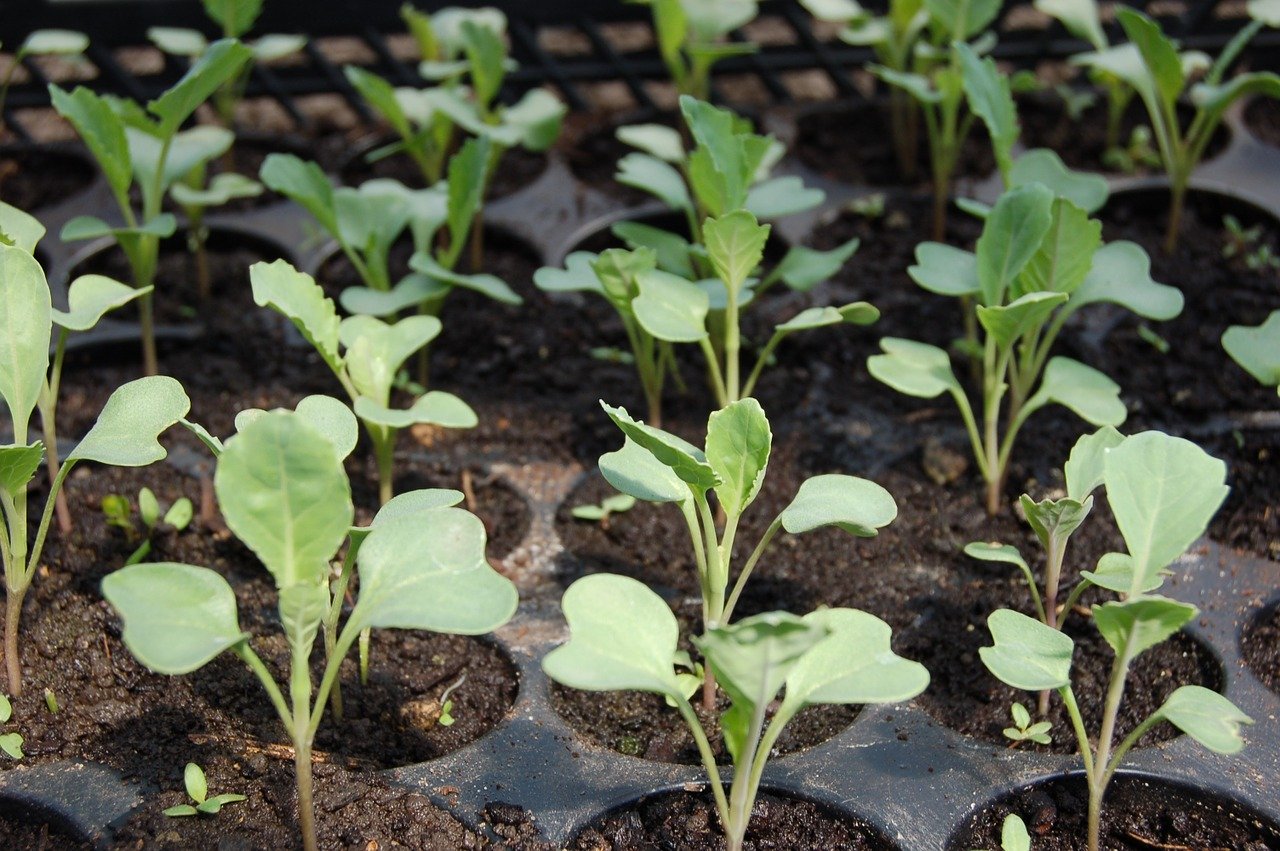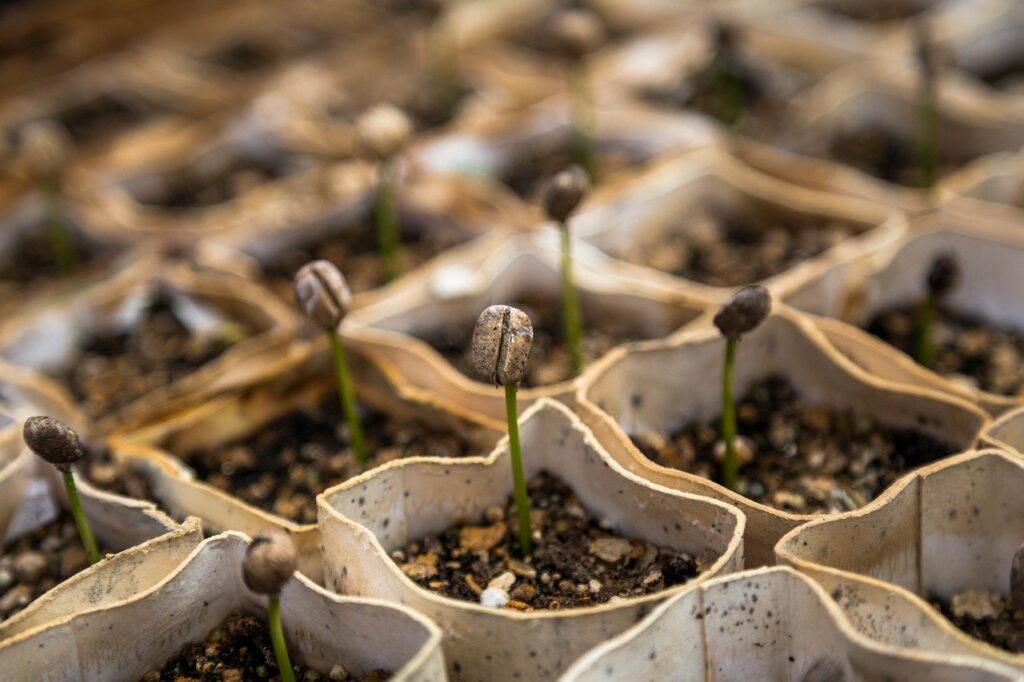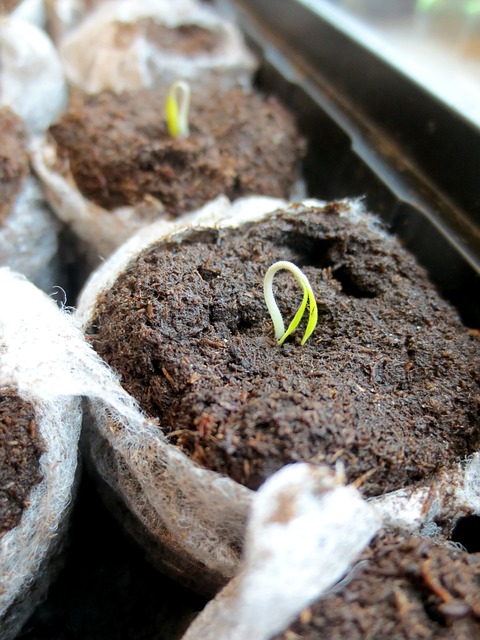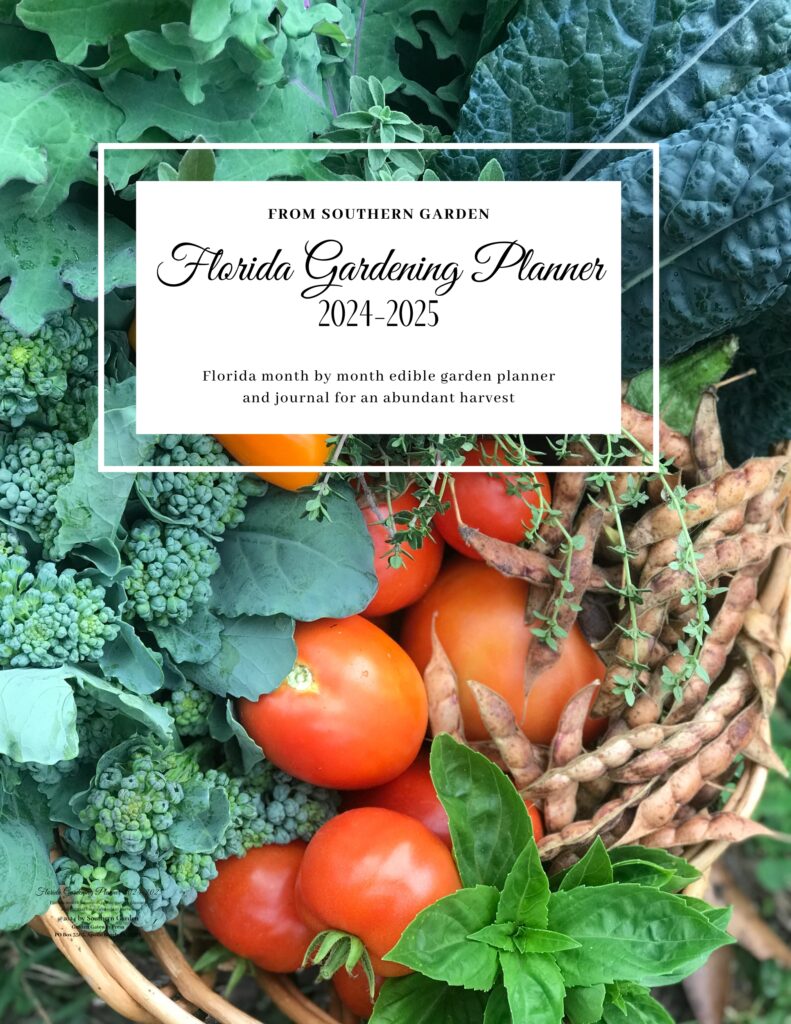
Depending on where you live, you may already be planning your spring garden. Here in Zone 10a, I’m starting seedlings now to plant out in mid-February. But, I’m running low on seed trays, so I’ve been shopping around to see what direction to go in this year.
What Are Seed Trays
What are seed trays? Seed trays are small containers that let you get plants started before the planting season. They consist of small containers for soil or planting medium that let you germinate many seeds at once.
When we talk about seed trays, most people are referring to cell flats. Those are the flimsy plastic containers with divided sections for starting your seedlings.
In most cases, you’ll get a number of cell containers of six or four cells with a large tray underneath to catch any water draining from the plants.
They also often come with clear plastic covers to help hold in heat and moisture. I rarely use them myself, because Zone 10a is hot and humid enough. And generally, I find that seeds germinate and outgrow the lids too quickly.
But don’t throw them away! They come in handy as watering pans.
Some seed trays also come with a heating pad to encourage some of the more heat-loving seedlings, like eggplant.
But not all seed trays are made out of flimsy plastic. Some upgraded models will be sturdier. And you can also purchase biodegradable seed trays so you don’t have to disturb the roots when you plant them out.
Alternatives to Seed Trays
Seed tray cells are my usual go-to. I have a few dozen of them, but this year, I plan to really fill in the borders. In the past, I’ve also used everything from Jiffy pods to toilet paper rolls. And while both work, they only work well under certain circumstances.
For example, while Jiffy pods are pretty awesome, they have limited capacity. So you really have to consider how long you have until you can plant them out.
Toilet paper rolls are pretty super, too, and they’re a great way to reuse something that would often end up in a landfill. But they’re delicate and may not hold together long enough.

Why Use Seed Trays?
If you want to get a jump on your planting season, seed trays give you a distinct advantage. Instead of waiting until the conditions are perfect to plant them outdoors in the soil.
In many Southern gardens, fall is the best time to plant vegetables. It can simply be too hot during the late summer to plant your veggies in the garden. In my area, it’s simply too wet! Damping-off is common, and it’s frustrating to watch your little seedlings fall over and die.
I start many of my spring seedlings in December, but there is still a risk of frost or the odd freak freeze. Starting my plants in seed trays allows me to move them easily indoors should the temperature drop.
Seed trays let you germinate strong, healthy seedlings under the best conditions until the outdoor conditions improve.
Vegetable Starts
The best reason for using seed trays is that they let you extend your growing season.
You want to plant out your seedlings as soon as you can after your last expected frost so you can get more out of your vegetable garden.
In Atlanta, for example, you have a 50-50 chance of a frost after April 4. So, why not give your plants a head start by germinating them in seed trays in February.
For me, the 50-50 point falls on January 4, although I usually wait a little longer. The 10 percent chance falls on February 14, so I need to get planting now!
But if you examine most vegetable seed packets, you’ll see that that they recommend planting by soil temperature, not by date. Using starter trays lets you control that temperature, either by starting them indoors or providing a heating pad.
And when you look at the cost of buying starter plants, you can see why starting your own seeds is so attractive. I think our local home improvement store sells vegetable starts at about $5 each. Since you can reuse your starter trays season after season, growing from seed is a real bargain.
Which Vegetables to Plant
If you’re thinking about starting your plants in trays, note that some plants aren’t suitable to starting in pots. They may have delicate roots that go into shock when transplanted.
However, the following all do well in starter trays, so consider peppers, lettuce, eggplant, and tomatoes. If you want to start cucurbits before your planting dates, you can also use biodegradable starters like Jiffy pots.
Always plant beans directly in the soil where you intend to grow them. They’re pretty hardy, so even if you plant them a little too early, you should have no trouble with them.
Flowers Starts
Using starter trays lets you add tons of color to your borders on the first planting day of spring. It seems like the cost of annuals has really exploded over the last five years. Investing in a set of good starter trays means you’ll be ready on that first day of spring.
You’ll also be able to add more throughout your growing season. Here in 10a, I’ve planted annuals in February only to see them expire in May. I’ve learned my lesson, and this year, I’ll be starting annual in succession to make the most of our long growing season.
And if you love perennials as much as I do, it’s great to get a nice long start on them by starting them indoors in the fall. They often grow very slowly, compared to annuals, so being able to plant out good size perennials that you’ve grown from seed can save you a lot of money.
Most annuals will do well in starter trays. Consider favorites like impatiens, petunias, and vinca.
And my one big money-saving trick? When you take cuttings, use your seed trays! They’re super for propagating small cuttings for future flowers.

Successful Seed Starting in Trays
Before starting any seeds in trays, do some research to find out how they handle transplanting. There’s always some debate, so as in all gardening, it can be a gamble. But you may win out if you experiment.
I’ve seen some sources say to always plant cucumbers directly, but I’ve had no problems starting them and transplanting them out using seed trays. Most of my trouble with cucumbers come much later in the form of powdery mildew.
Before you reuse your starter trays, make sure you wash them thoroughly with soap and water. While you may get lucky a few times, a thorough cleaning can help prevent disease spread.
You’ll also want to make sure you transplant them when they’re ready. Transplanting a rootbound plant can mean damage. If it’s still too cold (or too hot or too rainy), plant them up in a bigger pot to keep them thriving.
Best Seed Starter Trays to Buy
If you live in the South, it’s time to prepare for spring planting now. And if you need to stock up on starter trays, take a look at a few of my top picks.
Burpee Self-Watering Seed Starter Trays
- GROW LIKE A PRO: Complete indoor seed starting set includes two 36 cell…
- BIGGER, BETTER SEEDLINGS: Take the guesswork out of when and how often to…
- STAY ORGANIZED: Seed starting grow kit also comes with two plant-o-gram…
- GROW 72 SEEDLINGS: Tray has space for up to 72 seedlings in cells measuring…
- 100% GUARANTEED: Burpee is committed to the success of all gardeners. We…
These starter trays from Burpee guarantee your plant won’t perish of thirst. This design with a self-watering mat also prevents damping-off by maintaining the right level of moisture. It comes with growing medium pellets of coconut coir and a humidity dome.
Hydrofarm CK64060 Jump Start Starter Tray
- GERMINATION: Ideal environment for starting your seeds and cuttings by…
- POWER: This UL-listed waterproof heat mat runs at 17 watts, 120 volts
- HUMIDITY CONTROL: Features a 7-inch humidity dome for controlled humidity…
- WHAT’S INCLUDED: Includes heat mat, humidity dome, watertight tray, and…
- OPERATING TEMP: Operates 10 to 20 degrees Fahrenheit above ambient air…
If you need extra height for your starts, these seed trays have you covered. With a 7-inch dome lid, you’ll be able to provide plenty of room for your starter plants. It also comes with a heating mat to reach that perfect soil temperature. Offering 72 cells, you’ll be able to start plenty of beauties for your borders.
Park Seed Bio-Dome
- Climate control. You can remove the clear vent as the plants grow, but at…
- Incredible rooting medium. The bio sponge is simply the best way we’ve ever…
- Bottom watering. You water the base of this tray, NOT the bio sponges…
- Root strength. This goes along with #3 — these seedlings form LOTS of…
- Ease of transplant. None of this business of transplanting the plug into a…
Park Seed offers a sterling reputation, and its starter trays deliver some distinct advantages. This model boasts biosponges, so you won’t need growing medium until you reuse it. And you’ll want to reuse them because their sturdy construction will last for years.
Getting a Head Start on Your Garden
With no White Christmas here in Zone 10, it’s isn’t hard to start dreaming of a Green Spring. Seed catalogs have already hit the mailbox, and I need to get to work.
First, research the plants you want to grow and get a good idea of how much room they’ll need and how soon you’ll need to start them before your last frost date. Check out info from NOAA for your dates.
And make sure you get starter trays that are the right size for what you’re planting, including the depth and the height of any humidity dome.
Let me know what you’ve got planned and how you’re starting your seeds this spring. I’d love to hear from you.
Last update on 2025-06-19 / Affiliate links / Images from Amazon Product Advertising API
This product presentation was made with AAWP plugin.






